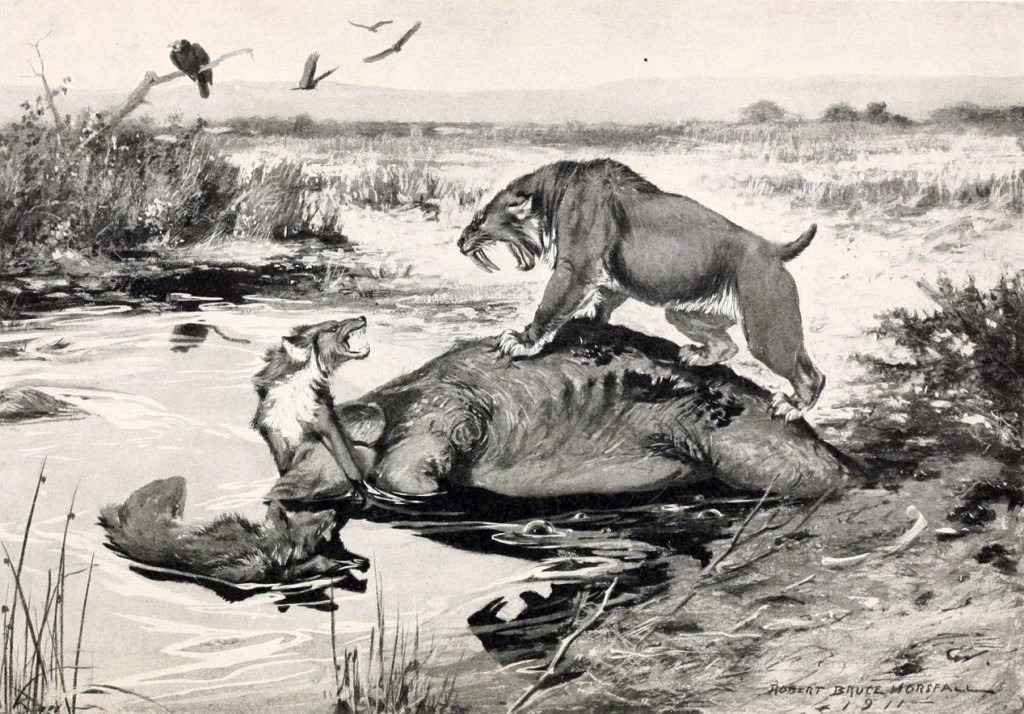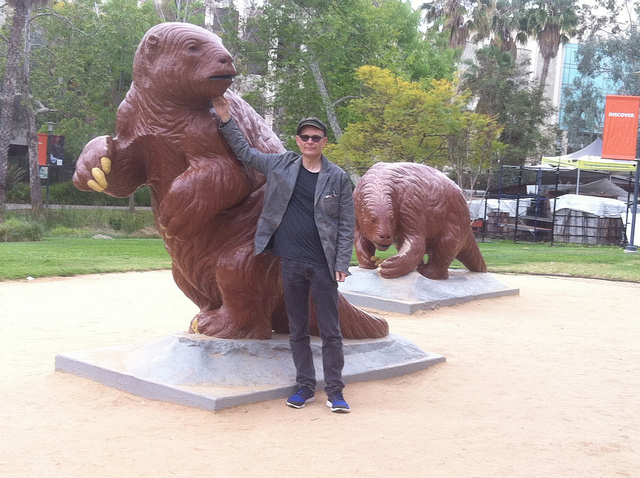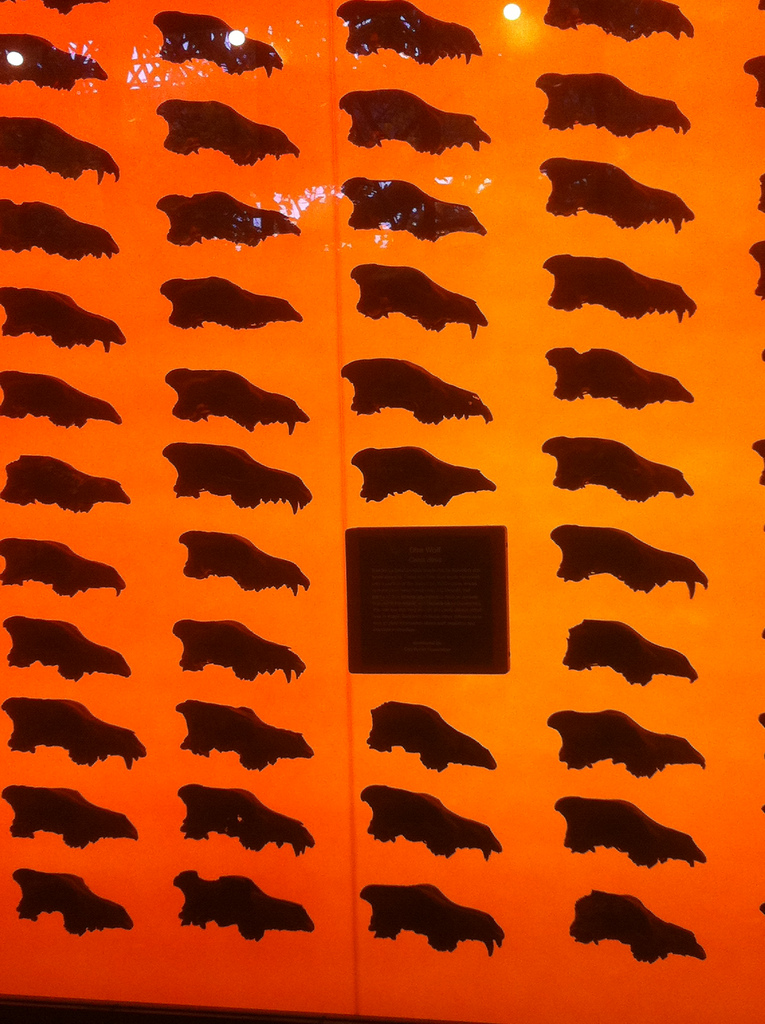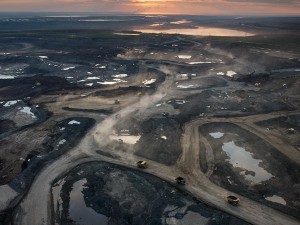The great blue bowl of the California sky has doubtlessly presided over some strange affairs, but perhaps none is stranger than the serial cycle of entrapment and petrification that started around 38,000 years ago in a collection of deceptively limpid ponds in what is now a quiet park in downtown Los Angeles. After it rains here, the play of sunlight and clouds is mirrored on their lambent surfaces, beneath which lies a menacing secret: for what first might appear to be a refreshing pool in an arid terrain is only a thin film of water obscuring an abyss of sticky bitumen, which has been oozing steadily from petroleum-bearing rock formations deep beneath the earth.
These are the notorious La Brea Tar Pits and since the days of the Pleistocene their peculiar configuration has served as both death trap and mausoleum for thousands of creatures–great and small, thirsty and merely curious–who venture into them and get stuck in their viscous pitch. Like a giant version of the ‘cockroach motel,’ once they ‘check in’ they never ‘check out’ and indeed the thrashing and bellowing of trapped victims attracts predators, whose natural wariness proves no match for the promise of an easy meal, ensuring they too are quickly doomed after jumping in for the kill. And so for thousands of years, whole conglomerations, entire food chains of animals have met their ends here: predators and prey sinking down alongside each other, each creature naïvely repeating the fatal mistakes of its predecessor: sabre-toothed cats and Dire wolves, with fangs and claws sunk into the contorted bodies of mastodons and camels, all of them frozen in elemental struggle as if in some Classical frieze. Not even the carrion eaters escaped the gruesome fate. Outsized vultures, giant condors and hideous, meat-eating storks, wheeling and squabbling for landing rights on the bloated corpses and almost corpses, snagged themselves when a carelessly extended talon or trailing pinion made contact with the merciless tar, that pulled them in, flapping and screeching , never to fly again. As well as being deadly, the tar has miraculous powers of preservation. The seething, interconnected beds of bone that have accumulated there have kept scientists busy ever since they first started excavating back in the early 1900s. Many of the rich paleontological finds are on display at the adjacent George C. Page Museum.
When I was a boy in Toronto back in the early 1960s, a small piece of the La Brea Tar Pits was on display in a dusty diorama at the city’s Royal Ontario Museum. This was a few years before the ROM adopted the loathsome trend for ’interactivity’, which consigned much of the museum’s extensive palaeontology collection to back rooms, out of public view, and what we got instead was an ersatz mishmash of mood lighting, audio tape loops and fibreglass models of dinosaurs standing aura-less amid plastic palm trees. Anyway before all that stupidity, I remember how transfixed I was ‘just looking’ at the thing itself, without being told how to think about what was in front of me – the tea coloured skeleton of a sabre-toothed cat, its outsized canines filigreed with tiny age cracks, poised to stab the neck of a hapless ungulate (a proto-camel? an extinct horse?) which had already begun to sink. It was the futility of it I remember the most, that both animals died together in the same inescapable way, the first doomed by thirst (or bovine idiocy), the second by carnivorous savagery. And I knew this scenario was to play itself out again and again because it was elementally and inherently unavoidable. Presiding over the sad scene was a tromp-l’oeil painted backdrop of a clot of vultures, hanging like wind-ripped umbrellas in the branches of a skeletal tree, and in broad brush strokes, a distant herd of mammoths melting into the horizon.
When I finally, this spring, got to tour the La Brea tar pits firsthand, I couldn’t help but see them as a kind of trope for contemporary times.
LA is a strange enough place to begin with–its palm-studded freeways and rivers of twinkling windshields pouring into the heat haze of the hyper- illuminated horizon–a place at once banal and startling, the High Baroque of American drive-thru suburbia amid scintillating beaches flooded in a golden, Canaletto-esque light. There are people there, of a certain age, whose faces have been so surgically altered it is as if they’ve been sucked through a magic wind tunnel. The mismatch between their wrinkle-less heads and the sun-withered bodies is chimerical, as if bands of Surrealist ‘exquisite corpses’ had gone AWOL, pulling themselves off the canvases and walking around. Los Angeles is the very essence of the American Anthropocene and yet prehistory bubbles and belches everywhere just beneath the surface. The city sits astride a massive oil field, where serried ranks of mini malls and tract homes lie nestled in the napes of brown hills and rustling eucalyptus groves, the edges of which bleed into a kind of terrain vague of ponderously nodding pump jacks tirelessly sucking petroleum out of a deposit dating back to the Miocene– a geologic epoch already long gone by the time the first mammoths sank into the tar.
Wandering through the pleasant grounds of Hancock Park, the past becomes the present and one soon encounters a pair of giant, chocolate-coloured ground sloths, like outsized Easter confections, placid and dim-witted in expression, yet armed with menacing fore claws that could easily rip the face off almost any attacker. As late as 10,000 years ago, these ungainly beasts lumbered across what was a vast North American range – their remains having been found from the Yukon to Mexico. At La Brea, they were regular victims to the suffocating tar.
In a still bubbling tar pit encircled by construction fencing, a family replica of gigantic Columbian mammoths replays a pathetic tableau. An adult is hopelessly stuck in the pit, its mouth agape in panic, its trunk frozen between the great curved brackets of its tusks, frantically gesturing to its mate and calf who stand helplessly on shore. The theme of serial entrapment and the futility of instinct gets amplified as soon as one enters the museum, which is packed with reconstructed skeletons and glass cases full of phylogenetically arranged remains, memorializing the legions of hapless creatures who died there over thousands of years, who just couldn’t stop themselves from making the same fatal mistakes over and over, in a senseless and recurring cruelty against which no benevolent god or Walt Disney narrator would intervene to warn ‘Stay out of those pits, yo!’ If only Spielberg had been in charge…
In paleontological terms, the tar pits are what is known as an ‘evolutionary trap.’ These create a stimulus that certain species are unable to resist and the results are often fatal. A contemporary equivalent has been the sad epidemic of dying albatrosses we’ve been seeing on Pacific Islands, their body cavities packed with bits of plastic that they seem programmed to snatch up from the waves and swallow in place of their natural food. Like the victims of La Brea, they just can’t help themselves.
Back at the Tar Pits, the Dire wolf (Canis dirus) seems to have been a particularly slow learner. To date the remains of over four thousand of them have been found there with doubtless many more to come. One of the more impressive displays at the George C. Page is a long, back-lit display, like something out of a high-end shoe store, containing hundreds of Dire wolf skulls, each an embodiment of one individual’s lack of impulse control. It seems that whenever a pack of them came upon an animal in distress in the tar, they would pile right on in on top of it, dooming themselves by their own overly developed killer instincts and susceptibility to peer pressure. The fact that the Dire wolf seems to have been exceptionally competitive, didn’t help matters. Males in areas where there was high population density developed outsized fangs with which to fight each other. It’s hard not to imagine the pack dynamic being a rather savage affair, especially when they chanced upon a bleating animal, trapped in tar. For the Dire wolf, there likely wasn’t a lot of time for second guesses. Though heavier and likely much meaner than their little cousin the coyote (Canis latrans), the Dire wolf failed to survive the Pleistocene, while the coyote still thrives in LA’s hills and canyons, feeding on what it finds in trash cans and snatching up unguarded pets. Though the Tar Pits weren’t the only factor in the Dire wolf’s continent-wide extinction, the evidence of its behaviour at La Brea indicates an inherent inflexibility, which must have been a major handicap in what, at the end of the Pleistocene, was a rapidly shifting set of conditions including changes in climate and the incursion of the first Paleo-Indians into its environment, who competed aggressively with the wolf for prey.
Though we may think our species’ ability to show foresight gives us particular resiliency–after all we started out in minuscule numbers, survived an Ice Age and proceeded to take over the world–we find ourselves now under a similar delusion to that which befell those hapless beasts at La Brea. Could it be that in the black, viscous materiality of petroleum we have finally met our match? Though we may think we have mastery over our fate, we seem blind to the possibility that it might be a substance that has control over us…
As an evolutionary trap– a nemesis–petroleum is the perfect agent. It is the very essence of death, a distillate of corpses from untold myriads of prehistoric organisms, which has quietly waited for us beneath the earth. If substances possess their own agency, as Jane Bennett surmises in her (2010) Vibrant Matter, is it so far-fetched to suggest that petroleum is luring us in, manipulating our innate behavioural vulnerabilities to ultimately absorb us into its oozing corpus? Like the sabre-toothed cat and Dire wolf before us, petroleum has exerted its ability to hypnotize, to communicate directly with our vulnerable animality, bypassing our much vaunted capacity for reason and discernment. It’s not that big a leap from the Tar Pits to the Tar Sands…
As happened to the Pleistocene creatures who got stuck in it when they put aside their caution, petroleum–ever protean– has set its exquisite trap for us in the form of a fata morgana, which gives us the illusion of eternally abundant and convenient energy with no long-term consequences. We are probably already in too deep to realize what has happened; that we are becoming petroleum, absorbed by the wily substance to become one with its subterranean deposits.
The Anthropocene might be remembered as a geologically brief period during which our species was allowed an overdraft, a blip during which we extracted a quantity of the black ooze before we had to repay our loan with the highest of interest; our lives, and those of the countless other organisms we took with us after we have made the planet uninhabitable. In so doing, we are offering up billions of putrefying corpses, untold tonnage of petrochemical garbage and entire landscapes of withered vegetation to be re-incorporated into the geologic, where unstoppable tectonic regimes will reprocess it into the mother of all oil fields.
So it is a mistake perhaps to wax too moralistic about our failure to rein in our natural impulsivity, to plan sensibly or imagine a future free from our addiction to this substance. Our connection to it might be too deep, too genetically encoded for us to resist through mere self critique.
Following the logic of the Dire wolf, our own species is competing increasingly viciously for what is (for the geologic moment anyway) a limited resource. The power elites in localities dependent primarily on petroleum production (Russia, Nigeria, Libya and others) have drawn whole societies into animality and impulsivity.
Even Canada, long a role model for liberal democracy, has slid into this petro-brutality. Under the prime ministership of oil-mad Stephen Harper, its government has declared a totalitarian war on scientists who study climate change and associated environmental contamination. The uncomfortable facts they keep bringing up highlight Canada’s abysmal record on these matters, which, aside from being an international embarrassment, threaten to push the usually complacent Canadians into a confrontation with the ecological Real (boring!, depressing!), invoking questions the Harper government is determined not to let us ask. Important and long-standing research facilities and environmental monitoring stations have already been shuttered, their scientists sacked and the scholarly material packed away or even thrown into the garbage. Those few scientists still working have been given STASI style minders, through which all communication with the public must be vetted. They even shadow the scientists at academic conferences to make sure they don’t say anything deemed ‘off message’ to the government’s single-minded agenda.
Yet given that our attraction to petroleum is demonstrably biological, can we really blame the individual oil worker, warlord or myopic Canadian bureaucrat? By doing their part to hasten mass extinction, they are in the service of the long term interest of petroleum itself. By extending its sticky tendrils through a higher dimensional space than most of us are letting ourselves imagine, petroleum assumes the characteristics of what the philosopher Timothy Morton calls a ‘hyperobject,’ an entire set of relationships, interactions agencies and desires of which we are but a small and transient part.






